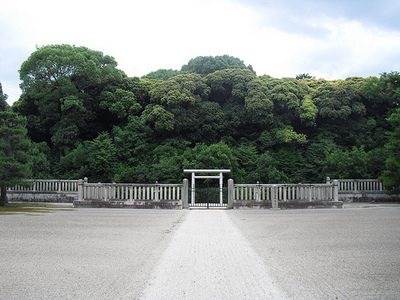Difference between revisions of "Emperor Kammu"
(Created page with "*''Born: '' *''Died: '' *''Reign: 781-806'' *''Japanese'': 桓武天皇 ''(Kanmu tennou)'' Emperor Kammu (r. 781-806) reigned over the establishment of [[Kyot...") |
(succession) |
||
| (4 intermediate revisions by the same user not shown) | |||
| Line 1: | Line 1: | ||
| − | + | [[File:Kammu-tomb.jpg|right|thumb|400px|The tomb-mound of Emperor Kammu, in [[Fushimi]].]] | |
| − | *''Died: '' | + | *''Died: [[806]]'' |
| − | *''Reign: [[781]]- | + | *''Reign: [[781]]-806'' |
*''Japanese'': 桓武天皇 ''(Kanmu tennou)'' | *''Japanese'': 桓武天皇 ''(Kanmu tennou)'' | ||
| Line 14: | Line 14: | ||
Emperor Kammu is buried in [[Fushimi]]; just over 1100 years later, in [[1912]], the tomb of [[Emperor Meiji]] was established nearby. | Emperor Kammu is buried in [[Fushimi]]; just over 1100 years later, in [[1912]], the tomb of [[Emperor Meiji]] was established nearby. | ||
| − | Among his sons were his successor, [[Emperor Heizei]], and [[Iyo-shinno|Prince Iyo]], from whom the [[Kono clan|Kôno clan]] claimed descent. | + | Among his sons were his successor, [[Emperor Heizei]]; [[Prince Kazurahara]], from whom the [[Kammu Heishi]] ([[Taira clan]]) claimed descent; and [[Iyo-shinno|Prince Iyo]], from whom the [[Kono clan|Kôno clan]] claimed descent. |
| + | |||
| + | <center> | ||
| + | {| border="3" align="center" | ||
| + | |- align="center" | ||
| + | |width="35%"|Preceded by<br>'''[[Emperor Konin|Emperor Kônin]]''' | ||
| + | |width="25%"|'''Emperor of Japan<br>[[781]]-[[806]]''' | ||
| + | |width="35%"|Succeeded by<br>'''[[Emperor Heizei]]''' | ||
| + | |} | ||
| + | </center> | ||
==References== | ==References== | ||
| Line 21: | Line 30: | ||
[[Category:Nara Period]] | [[Category:Nara Period]] | ||
[[Category:Heian Period]] | [[Category:Heian Period]] | ||
| − | [[Category:Emperors]] | + | [[Category:Emperors|Kammu]] |
Latest revision as of 20:45, 25 January 2014

Emperor Kammu (r. 781-806) reigned over the establishment of Kyôto, then known as Heian-kyô, as the capital of Japan. He is thus one of the most important emperors in history - Kyoto would remain the imperial capital for over 1000 years after his death.
He succeeded his father, Emperor Kônin, to the throne in 781.
Ten years prior to the establishment of Heian-kyô, Kammu also presided over the moving of the capital first to Nagaoka-kyô from Heijô-kyo (today known as Nara), which had been the capital for the previous 74 years or so. These moves away from Nara, it is said, were spurred mainly by a desire to distance the seat of secular power from that of the major Buddhist temples; it was for that reason as well that Kammu strictly limited the construction of major temples in the new capital for a time.
His reign saw battles against the Emishi (natives to the north), meaning further expansion and/or securing of the borders of the state; he also sponsored the journeys of Saichô and Kûkai to China - they returned to found the Shingon and Tendai schools of Buddhism, and to become hugely prominent Japanese historical figures.
Emperor Kammu is buried in Fushimi; just over 1100 years later, in 1912, the tomb of Emperor Meiji was established nearby.
Among his sons were his successor, Emperor Heizei; Prince Kazurahara, from whom the Kammu Heishi (Taira clan) claimed descent; and Prince Iyo, from whom the Kôno clan claimed descent.
| Preceded by Emperor Kônin |
Emperor of Japan 781-806 |
Succeeded by Emperor Heizei |
References
- Plaques on-site at the tomb of Emperor Kammu in Fushimi.